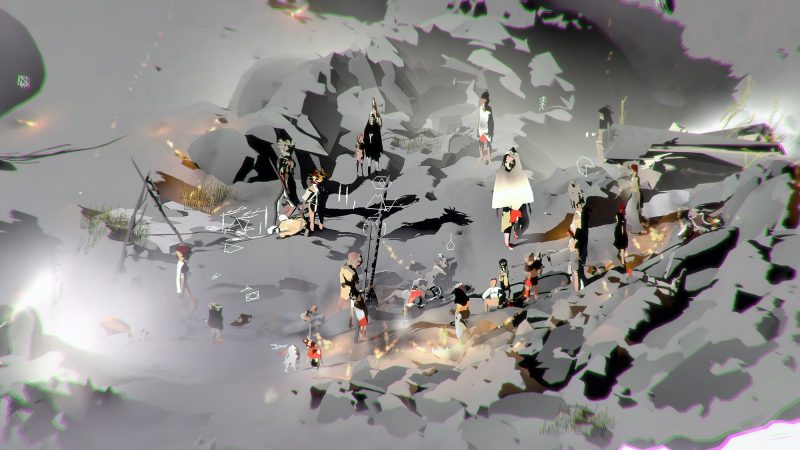Worlding through Simulation and Losing Control
Posted on October 22, 2021Science fiction writers are often referred to as “world-builders” as they strive to construct an imaginary world in a fictional universe. [1] What exactly is a world, and who is building this world we are living in? Is a world ever going to be finished with “building”? Can we understand how a world works through remaking and simulating it? In an attempt to answer these questions, artist Ian Cheng (b. 1984) produced a series of live simulations titled the Emissaries Trilogy, exploring an agent’s capacity to deal with an ever-changing environment. Cheng described each episode in the Emissaries trilogy as “a video game that plays itself,” a story that has no beginning and no end. The works comprise computer-generated simulations like those used in predictive technologies for complex scenarios such as climate change or elections. [2]

Ian Cheng. Emissary in the Squat of Gods. 2015. Live simulation and story.
I first saw the Emissaries Trilogy in Cheng’s solo exhibition at MoMA PS1 in 2017. At first, I was amazed by the non-homogeneity of its visual elements – when depicting nature using digital technology, Cheng made sure nothing in the background or foreground was repetitive, just as you can’t find two identical leaves in nature. His effort to imitate nature is also shown in how he “world-build” in his simulations: chaos and order co-exist; competing internal personal goals co-exist; motivations of different characters co-exist. “We don’t expect nature to have complete control or total determinism,” Cheng said in an interview, “I often felt when making my work that I needed that container (nature) to make an analogy to the out-of-control-ness we experience in our lives.” [3] Darwin said the greatest live simulation is nature herself; however, it is challenging to observe her on a human scale – she’s either too fast for us to catch up to or too slow for us to notice. Cheng’s video works provided a portal and an analogy to observe such simulations in human spacetime.
To create a simulation that truly imitates nature, Cheng had to give up control. As Donna Haraway illustrated in her book Staying with the Trouble, the world is “messy and imperfect, and actively generative.” [4] Giving up control means embracing such messiness, living with it, and allowing emergence to begin. In the live simulations, Cheng set up the narrative premise and the goals of his main character, the Emissary; then, he released control. At the same time, Cheng collaged together different models of the brain from philosophy, computer science, and video games and assigned them to different characters surrounding the Emissary. As audiences, we got to see how the Emissary’s goals compete against and influence those of other characters in the simulation, as these AI models randomly interact and compete with each other, creating emergence effects. As a result, the outcome of the “groupthink” within the live simulations became impossible to predict. As also mentioned in Steve Johnson’s book Emergence, the fundamental law of emergence is that the individual agents’ behavior is less important than the overall system. [5]
Are science fiction writers the only “world-builders”? When today’s designers and artists speculate about possible futures, they also exercise their ability to world-build. To Ian Cheng, worlding is the art of devising a world: “by choosing its dysfunctional present, maintaining its habitable past, aiming at its transformative future, and ultimately, letting it outlive your authorial control.” [6] As Haraway describes the practices of string figures as “risky”, worlding brings about the sense of unease that we humans associate with things unknown, uncertain, and uncontrollable.
Not everyone would identify themselves as “world-builders”, a term that implies an abstract sense of god-like authority; however, we can all acknowledge that we are actors influencing each other on human scales. As humans, just the presence of another person is enough to influence how we think and what we do in life. In the Chthulucene, Haraway argues that humans are not the only important actors – we, along with other beings, are with and of the earth, and “the biotic and abiotic powers of this earth are the main story” [4]. The questions we ask then become philosophical ones: how does one live with such out-of-control-ness we experience in a messy, “risky” world? Does one’s own agency matter when the behavior of a group matters more? What does it really mean to “dance” with all beings of the earth when everyone and everything is so interconnected?
SD
- Hamilton, J. (2009). Science Fiction (You Write It!). Abdo Group. pp. 8–9.
- Ian Cheng: Emissaries (2017): MoMA PS1. https://www.moma.org/calendar/exhibitions/3656
- Ian Cheng: A Portal to Infinity. (2019, August 6). Louisiana Channel. https://channel.louisiana.dk/video/ian-cheng-portal-infinity
- Haraway, D. J. (2016). Staying with the Trouble: Making Kin in the Chthulucene. Duke University Press Books.
- Johnson, S. (2002). Emergence: The Connected Lives of Ants, Brains, Cities, and Software.
- Cheng, I. (2019, March 5). Worlding Raga: 2 – What is a World?. https://www.ribbonfarm.com/2019/03/05/worlding-raga-2-what-is-a-world/